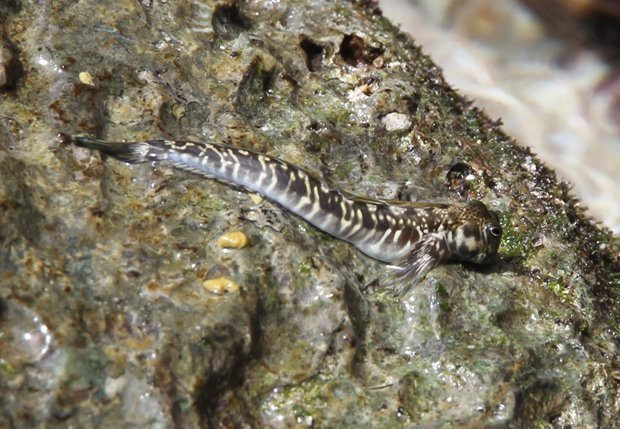Oddball land-loving fish puzzles experts

A BIZARRE SPECIES OF leaping, land-dwelling fish uses camouflage to avoid being eaten by predators – and now new research suggests it developed this disguise before it even left the water.
The Pacific leaping blenny (Alticus arnoldorum) is a terrestrial fish that lives on the rocky shorelines of Pacific islands. The blenny spends its entire adult life on land, using a unique tail-twisting movement to leap across exposed rocks in the splash zone, where it feeds on algae.
For the first time, scientists have confirmed that the body colour of the Pacific leaping blenny matches the colour of its habitat, to avoid attacks from land predators such as birds, crabs and lizards.
However, the study, published last week in the journal Animal Behaviour, also shows that the blenny’s marine ancestors had most likely adapted to match the colour of the rocky shoreline before the fish transitioned from life in the water to life on land.
Surprising evolution from leaping fish
“We weren’t surprised to discover that this land fish evolved cryptic body coloration and patterning to blend in with its rocky habitats on land to avoid being eaten,” says Dr Terry Ord, the study’s senior author from the University of New South Wales in Sydney.
“The surprise was that this appears to have occurred before the fish actually ventured out onto land.”
Terry and his co-author Courtney Morgans measured the colours of five blenny populations on Guam, a tropical island in the western Pacific Ocean. “We used computer software to analyse the colour of the fish relative to their backgrounds and we were able to confirm that these fish are matching their habitats very closely,” says Terry. “Generally speaking, all the populations around the island are camouflaged in their respective environments.”
The researchers then monitored predation, showing that blennies outside of their camouflaged habitat were under more threat from predators.
Fish out of water: Evolutionary camouflage
The pair also studied the body colour of a number of fish species closely related to the blenny. Some of these species live in water and others are amphibious, spending time on land and in the sea. The aquatic and amphibious fish all had similar body colours to the land-dwelling blenny. This suggests that the blenny’s ancestors matched the colour of the rocky shoreline before the species transitioned to live on land.
“If they hadn’t been cryptically coloured at the outset, the fish would probably have had difficulty in first making the transition, because they would have been conspicuous to predators and been eaten before they could establish on land,” says Terry. He adds that reduced predation would have made it easier for the blenny to overcome other challenges such as evolving to be able to breathe and move about on land.
“Camouflage is one of the most important adaptations for survival and it is very important for us to understand the different mechanisms animals use for camouflage,” says Dr Devi Stuart-Fox, a zoologist at the University of Melbourne.
“Understanding the transition from water to land is also fascinating and marrying the two makes this recent study particularly interesting.”
The Pacific leaping blenny is one of many species that have made the transition from water to land. Terry also plans to investigate how other adaptations have allowed fish to survive out of water and how terrestrial fish evolved following their move to land.
RELATED STORIES

